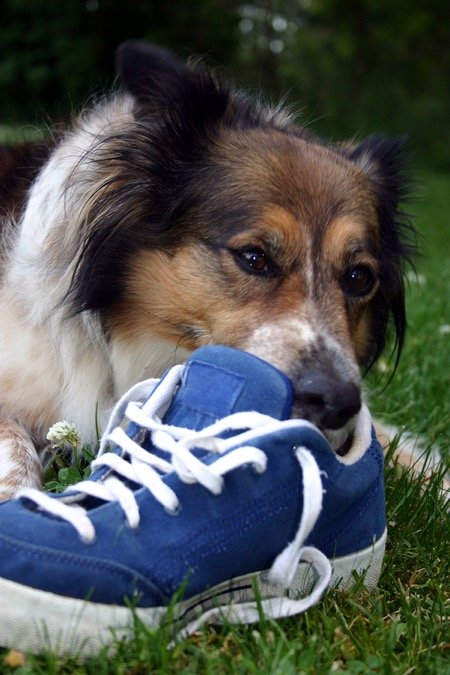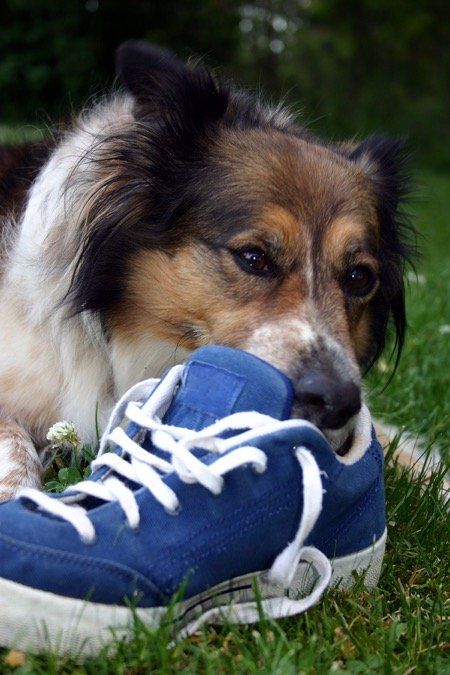Say “pica,” and many people will think of a nutritional deficiency, as in eating a non-food item to get enough of a mineral or vitamin that’s missing from the diet. But pica in people is characterized almost exclusively as a psychological disorder rather than a nutritional one, especially in industrialized countries like the United States; it’s extremely rare that a person will crave something that isn’t food to satisfy a nutritional need.
Dogs don’t eat non-food items to correct nutritional deficiencies, either, even though many people think that’s the case. “Dogs eating rocks or dirt is usually what brings clients to me worried that their dog has a nutritional deficiency,” says Tufts veterinary nutritionist Cailin Heinze, VMD, DACVN. “But eating non-food items has never been clearly linked to a nutritional deficiency in dogs — or cats,” she points out. “Birds eat certain kinds of clay in the wild, and we think they’re doing it for minerals. But that’s a totally different situation. The dogs I see because their owners are worried are generally eating balanced diets that I have no concerns about. I’ve never been able to say that when we fed a dog x nutrient, the eating of non-food items went away.”
Dr. Heinze doesn’t rule out occasional pica in dogs to handle an upset stomach. It appears that some dogs will eat grass to help them throw up and get relief when they’re feeling nauseated. But that has nothing to do with insuring adequate consumption of nutrients. In fact, some dogs may eat grass simply because they can, Dr. Heinze says, and that may make them nauseated rather than relieve nausea. “It’s kind of the chicken versus the egg,” she says. “We just don’t know.”
It’s not clear that pica is a sign of a psychological disturbance in most dogs, either. “Eating a sock is pretty normal behavior for a dog,” Dr. Heinze says. “And while it makes no sense to us for a dog to eat a corn cob or a barbecue skewer, they do it all the time.”
An animal behaviorist weighs in
The head of the Tufts Animal Behavior Clinic, Stephanie Borns-Weil, DVM, agrees with Dr. Heinze that chewing and then swallowing a sock is not abnormal for a dog. “Chewing is normal canine behavior,” she says. While it can be dangerous, causing obstructions in the stomach or intestines that require surgical fixes, it does not signify that something is askew, either nutritionally or psychologically.
© Darin Burt | Bigstock

“You have to think about it from the dog’s perspective,” Dr. Borns-Weil remarks. “What they consider to be a food item is often different from what we would think of as one. They think of horse and cat feces as food items. Or dish towels that have food remnants. Or tissues with nasal discharge. We think their eating used tissues is naughty, but they think it’s yummy.”
Dr. Borns-Weil also concurs with Dr. Heinze that sometimes a dog may eat something like grass as an emetic to find relief in instances of GI upset. Eating grass may also be a natural anti-parasitic action, she says, “cleansing the system,” if you will.
In other words, eating non-food items usually does not signify a behav-ioral issue, especially in young dogs, she comments. Dogs just like to eat things. But that doesn’t mean it can’t result in problems. Because of the danger of gastrointestinal obstructions, you may have to “keep your house picked up,” she says, so your pet can’t get at things that could end up in an emergency visit to the vet’s office. And having a dog who tends to swallow non-food items wear a head halter outside rather than just a leash with a conventional collar can help you readily tug his head away from something that could cause a blockage once inside his body. In some cases, you may want to use a basket muzzle if, say, the dog has a penchant for chewing up sticks; little slivers of sticks can cause various problems if they get stuck behind the eye or certain other areas. (Note: Some owners believe that a dog who needs surgery because of having ingested a foreign object will learn from the experience and not do it again. Not true, as we know firsthand from the dogs who pass through our surgical suites a second — and sometimes third — time to have objects removed. They have no way of connecting their action to the operation that follows.)
You can also teach your dog an alternate behavior — like looking at you rather than chomping down, in return for a delectable treat. Maybe you can even get the dog to carry something in his mouth that’s incompatible with chewing sticks and other non-food items he comes across. Some dogs are very “proud” to carry their special ball or other object while out on a walk.
When the pica gets out of hand
Despite the fact that it is totally normal for a dog to eat things with no nutritive value, there are instances when consumption of non-food items is “out of context and out of scale,” Dr. Borns- Weil points out. “If the behavior is excessive to the point that the dog eats everything all the time, then you have true abnormal behavioral pica. I don’t see it very often. It’s more common in cats. But it does happen.” Why?
In some instances, it might be a displacement behavior resulting from “insufficient stimulation” or anxiety, or a combination, the doctor says. A lot of times, if the dog doesn’t have enough to do (his stimulation might consist of your opening the back door and letting him into the yard to sit by himself), he will become not just bored but also anxious and engage in eating non-food items as a way to quell his unsettled moods. “It’s like going to the refrigerator and eating food when you’re not hungry” but, rather, feeling bored or stressed, Dr. Borns-Weil says. The eating displaces activities that the dog is missing or distracts from the stress a bit.
Sometimes it’s stress alone rather than stress tinged with boredom that leads to the behavior. Dr. Borns-Weil speaks of one dog she knew who started eating everything in sight when she realized her owner was about to leave the house — pencils, papers, etc. The dog had severe separation anxiety that she dealt with by chewing and swallowing whatever was in her path.
Sometimes, eating non-food items as a displacement behavior could progress to a true compulsion that goes on at every opportunity, separate from the situation that got it going in the first place, Dr. Borns-Weil remarks. What started out as a boredom or anxiety-relieving displacement ramps up to an OCD-like condition.
What can you do about it? For insufficient stimulation, the answer is straightforward. You’ve got to engage your dog in more active time with you — going on walks to new places, setting up play dates with other dogs, throwing a Frisbee or ball or toy around with him, or taking him to agility classes or other courses that will meet his considerable needs for using his body and mind.
If stress is involved, you have to work on the underlying problem. For separation anxiety, for instance, it’s important to work gradually and consistently toward getting your dog used to your going out of the house without him — by leaving around plenty of interesting toys, playing games such as putting food morsels in hard-to-get-at puzzles, and slowly increasing the time you are away from home. This can start with leaving the house for literally several seconds and increasing over a number of weeks or months to several minutes, and then longer.
If the anxiety — or compulsion — leading to the ingestion of non-food items is very deeply rooted, you may want to consider introducing an SSRI such as Prozac (fluoxetine) to get your dog over the hump while training him in new behaviors, Dr. Borns-Weil says. But that’s for the truly intractable cases that perhaps endanger a dog’s safety on a regular basis. More commonly, the eating of non-food items by dogs can be dealt with via behavioral and training fixes. And most often of all, eating non-food items here and there is just part of what makes a dog a dog.






Hi, This is a great article and the first I’ve found that discusses that there is really no proven link between diet and PICA. But I would like to suggest a change in wording. You say:
“And having a dog who tends to swallow non-food items wear a head halter outside rather than just a leash with a conventional collar can help you readily tug his head away from something that could cause a blockage once inside his body”
I’d like to suggest that instead of saying “tug his head” you say “MOVE” his head. As a positive reinforcement dog trainer, I can say that “tugging on a head collar” is not going to help a dog who is eating things out of anxiety. It may seem nit-picky, but R+ trainers like me are constantly struggling with people to NOT yank their dogs leash (in the face of all the “leash popper” trainers out there). I’d prefer that a veterinary hospital not add to this problem. Thank you.